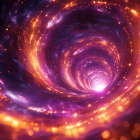Gravity is the invisible force that attracts objects of mass to each other, and for centuries scientists have grappled with this and the rest of the fundamental forces that govern our universe. But an invisible mass resists us in the cosmos – first proposed by the Dutch astronomer Jan Oort in 1932 -, a missing mass that theoretically holds galaxies together and which we know as dark matter. There seems to be a lot more matter present in the universe than can be explained only with visible matter.
Dark matter would explain gravitational effects that general relativity cannot explainMidjourney/Sarah Romero
Does dark matter exist or not?
Unlike ordinary matter, which we can see and interact with directly, Dark matter does not emit, absorb or reflect light, which makes it invisible to telescopes and other detection instruments. The idea of dark matter gained greater traction in the 1970s thanks to the work of the American astronomer Vera Rubin. Rubin studied the rotation curves of spiral galaxies and discovered that the outer regions of these galaxies rotated at speeds that could not be explained solely by the gravitational pull of visible matter. The exact nature of dark matter remains one of the biggest mysteries in modern physics.
It is quite an enigma but, for the first time, a team of researchers from the University of Alabama in Huntsville (UAH) has shown to be able to solve this mystery: and it is that gravity can exist without mass, offering an alternative explanation capable of eliminating the need for dark matter in the universe at a stroke and adding a new twist to this old problem:

“My own inspiration came from my search for another solution to the gravitational field equations of general relativity, the simplified version of which, applicable to the conditions of galaxies and galaxy clusters, is known as Poisson’s equationwhich provides a finite gravitational force in the absence of detectable mass,” explains Richard Lieu, professor of physics and astronomy at the University of Alabama in Huntsville and lead author of the study reported in the magazine Monthly Notices of the Royal Astronomical Society. “This initiative, in turn, is driven by my frustration with the status quothat is, the notion of the existence of dark matter despite the lack of direct evidence for an entire century.”
Dark matter does not emit, absorb or reflect light, making it invisible to telescopes.Midjourney/Sarah Romero
First demonstration that gravity exists without mass
According to scientists, the concentric sets of layer-like topological defects in structures commonly found throughout the universe may be the source of the “excess” gravity needed to hold a galaxy or cluster together. Most likely These ‘defects’ were created during the early universewhen a cosmological phase transition occurred, in which the general state of matter changes at the same time throughout the universe.
“Both light bending and stellar orbital velocities are the only means by which the strength of the gravitational field in a large-scale structure, whether a galaxy or a galaxy cluster, is measured. The argument of my article is that at least the layers that are postulated have no massthen there is no need to perpetuate this seemingly endless search for dark matter,” says the expert.
UniverseMidjourney/Sarah Romero
Lieu emphasizes that his study does not seek to solve the problem of the formation of structures in the cosmos and admits that unanswered questions still remain about the initial condition of the layers and how to conclusively verify or deny their existence through concrete observations. Future research is likely to focus on how a galaxy or cluster forms through the alignment of these layers and how the evolution of structures occurs. What is clear is that brings a quite revolutionary perspective about the nature of gravity, which, in turn, would open new windows of understanding of our universe.
“Of course, the availability of a second solution, even if highly suggestive, is not in itself sufficient to discredit the dark matter hypothesis; At best, it could be an interesting mathematical exercise. But “It is the first proof that gravity can exist without mass.”concludes Lieu.
Dark matter is believed to constitute about 27% of the total mass and energy of the universe, while ordinary matter (everything we can see and touch) comprises only about 5%. The remaining 68% is believed to be dark energy, a mysterious force driving the accelerated expansion of the universe.
Its presence can be inferred through its gravitational effects on visible matterMidjourney/Sarah Romero
References:
- Richard Lieu. The binding of cosmological structures by massless topological defects. Monthly Notices of the Royal Astronomical Society. DOI: 10.1093/mnras/stae1258
- Behrman, J. (2021). Portrait of a groundbreaking astronomer. Science, 371, 788 – 788. https://doi.org/10.1126/science.abg1818.
- Dvorkin, C., Lin, T., & Schutz, K. (2020). Cosmology of Sub-MeV Dark Matter Freeze-In.. Physical review letters, 127 11, 111301. https://doi.org/10.1103/PhysRevLett.127.111301.
- Salucci, P., Esposito, G., Lambiase, G., Battista, E., Benetti, M., Bini, D., Boco, L., Sharma, G., Bozza, V., Buoninfante, L., Capolupo, A., Capozziello, S., Covone, G., D’Agostino, R., deLaurentis, M., Martino, I., Somma, G., Grezia, E., Paolo, C., Fatibene, L ., Gammaldi, V., Geralico, A., Ingoglia, L., Lapi, A., Luciano, G., Mastrototaro, L., Naddeo, A., Pantoni, L., Petruzziello, L., Piedipalumbo, E ., Pietroni, S., Quaranta, A., Rota, P., Sarracino, G., Sorge, F., Stabile, A., Stornaiolo, C., Tedesco, A., Valdarnini, R., Viaggiu, S. ., & Yunge, A. (2020). Einstein, Planck and Vera Rubin: Relevant Encounters Between the Cosmological and the Quantum Worlds. , 8. https://doi.org/10.3389/fphy.2020.603190.






